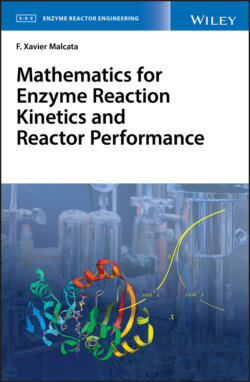Читать книгу Mathematics for Enzyme Reaction Kinetics and Reactor Performance - F. Xavier Malcata - Страница 24
2.2.2 Quotient
ОглавлениеWith regard to division of a dividend polynomial, say, Pn {x}, by a divisor polynomial, say, Pm {x}, one will eventually be led to
(2.141)
on account again of Eqs. (2.135) and (2.136) – provided that n ≥ m; here Qn−m denotes an (n – m)th degree quotient polynomial, and R<m denotes a remainder polynomial of degree not exceeding m. The underlying algorithm is but an extension of Euclidean (long) division algorithm for regular numbers; one should thus start by dividing the highest order term, an xn, of the dividend polynomial by the highest order term, bm xm, of the divisor polynomial – so an xn−m /bm always appears as first term of the quotient polynomial; multiplication should then proceed of said quotient term by every term of the divisor – followed by subtraction of the result from the dividend. In other words, the first step of division should lead to
(2.142)
which simplifies to
(2.143)
after lumping factors and canceling an xn with its negative afterward; this is graphically illustrated in Fig. 2.7.The same algorithm may now be applied to the second term in the right‐hand side of Eq. (2.143), as long as n – 1 ≥ m, to produce
(2.144)
that degenerates to
(2.145)
after lumping the coefficients of similar powers of x – and the process may be iterated for the third term, the fourth term, and so on. The above algorithm is thus to be repeated until the degree of the polynomial in numerator of the last term is lower than its denominator counterpart; it may even reduce to zero – in which case Pn would be an exact (polynomial) multiple of Pm .
Figure 2.7 Graphical algorithm of (long) Euclidean division of polynomials on x – where …, an−2, an−1, an , …, bm−2, bm−1, and bm denote real numbers, while n and m denote integer numbers.
In the particular case Pm is a linear polynomial, of the form x − r, viz.
(2.146)
en lieu of Eq. (2.136) and meaning that b0 = −r and b1 = 1, the algorithm of division of polynomials simplifies to
(2.147)
which breaks down to
(2.148)
upon condensation of terms alike; a second application of said algorithm unfolds
(2.149)
where a similar condensation of powers alike gives rise to
(2.150)
This process may then be iterated until the numerator of the last term reduces to a constant – according to
(2.151)
– or, after having eliminated inner parentheses,
(2.152)
a graphical illustration – often known as Ruffini’s rule, is depicted in Fig. 2.8. Except for the first column – where the lower entry mimics the upper entry, the lower entry of every column entails the product of the previous counterpart by r, added to the current upper entry.
Figure 2.8 Graphical algorithm of (long) Ruffini’s division of polynomials – where a0, a1, a2, …, an−2, an−1, an, and r denote real numbers, while n denotes an integer number.
A more condensed notation is, however, possible based on Eq. (2.152), viz.
(2.153)
– by taking advantage of the concept of summation; note that the numerator of the last term coincides with Pn {x}|x = r, see Eq. (2.135). Said remainder will be zero, i.e.
(2.154)
when
(2.155)
Eq. (2.155) may be rephrased as
(2.156)
or, in view of Eq. (2.135),
(2.157)
Therefore, the linear polynomial x − r divides Pn {x} exactly – or Pn {x} is a multiple of x − r, when x = r is a root of Pn {x}.
